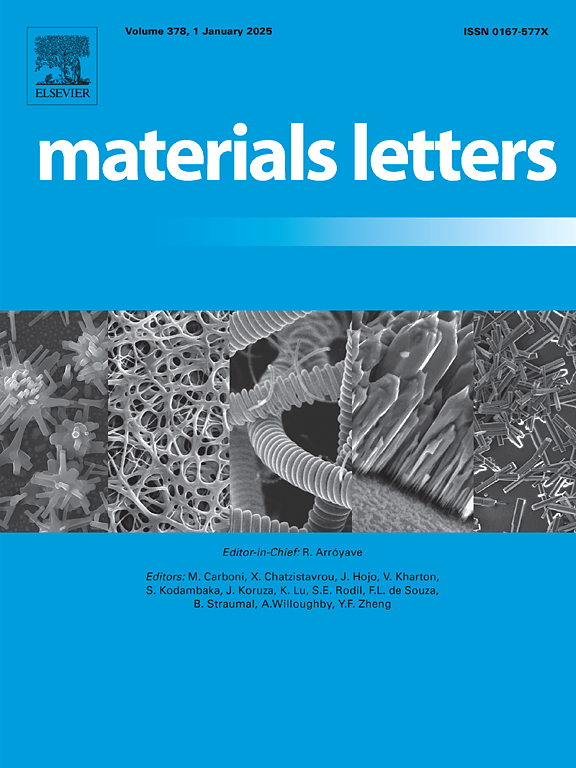Sn浓度对自旋镀膜法氧化锑薄膜的影响:结构和光学性质分析
IF 2.7
4区 材料科学
Q3 MATERIALS SCIENCE, MULTIDISCIPLINARY
引用次数: 0
摘要
利用自旋镀膜法合成掺锡Sb2O3薄膜,旨在研究不同Sn浓度对其光学和结构性能的影响,这是以前没有报道过的。FESEM显示,在厚度为6 ~ 13 μm的表面上存在六角形和立方形结构。EDS证实Sn在Sb2O3晶格中成功掺杂,XRD图谱表明,当Sn为0.1 M时Sb2O3为立方相,当Sn为0.2 M时Sb2O3为非晶相。从0.3 ~ 0.5 M Sn转变为正交结构。结构性能表明,0.3 M Sn掺杂具有最小的结构缺陷和无序性。此外,薄膜在可见光区的透过率接近90%,而在紫外线区的透过率则显著降低。0.3 M Sn掺杂具有较高的吸收系数、最低的乌尔巴赫能和最佳的带隙。这些发现强调了使用自旋镀膜方法制备高质量光学薄膜的必要性。本文章由计算机程序翻译,如有差异,请以英文原文为准。
Effect of Sn concentration on antimony oxide thin films via using spin coating method: Analysis of structural and optical properties
The synthesis of Sn-doped Sb2O3 thin films using the spin coating method aims to investigate the effect of various Sn concentrations on the optical and structural properties, which has not been previously reported. FESEM revealed some hexagonal and cubic-shaped structures on the surfaces with thicknesses ranging from 6 to 13 μm. EDS confirmed successful Sn doping in the Sb2O3 lattice, and XRD patterns identified a cubic Sb2O3 phase for 0.1 M Sn and became to an amorphous nature for 0.2 M Sn. The structure transformed to orthorhombic from 0.3 to 0.5 M Sn. The structural properties show that the 0.3 M Sn doping exhibits minimal structural defects and disorder. In addition, the films exhibited almost 90 % transmittance in the visible region and dramatical reduction in the ultraviolet region. The 0.3 M Sn doping exhibited high absorption coefficients with the lowest Urbach energy and optimal bandgap. These findings highlight the need for high-quality optical thin films fabricated using the spin-coating method.
求助全文
通过发布文献求助,成功后即可免费获取论文全文。
去求助
来源期刊

Materials Letters
工程技术-材料科学:综合
CiteScore
5.60
自引率
3.30%
发文量
1948
审稿时长
50 days
期刊介绍:
Materials Letters has an open access mirror journal Materials Letters: X, sharing the same aims and scope, editorial team, submission system and rigorous peer review.
Materials Letters is dedicated to publishing novel, cutting edge reports of broad interest to the materials community. The journal provides a forum for materials scientists and engineers, physicists, and chemists to rapidly communicate on the most important topics in the field of materials.
Contributions include, but are not limited to, a variety of topics such as:
• Materials - Metals and alloys, amorphous solids, ceramics, composites, polymers, semiconductors
• Applications - Structural, opto-electronic, magnetic, medical, MEMS, sensors, smart
• Characterization - Analytical, microscopy, scanning probes, nanoscopic, optical, electrical, magnetic, acoustic, spectroscopic, diffraction
• Novel Materials - Micro and nanostructures (nanowires, nanotubes, nanoparticles), nanocomposites, thin films, superlattices, quantum dots.
• Processing - Crystal growth, thin film processing, sol-gel processing, mechanical processing, assembly, nanocrystalline processing.
• Properties - Mechanical, magnetic, optical, electrical, ferroelectric, thermal, interfacial, transport, thermodynamic
• Synthesis - Quenching, solid state, solidification, solution synthesis, vapor deposition, high pressure, explosive
 求助内容:
求助内容: 应助结果提醒方式:
应助结果提醒方式:


